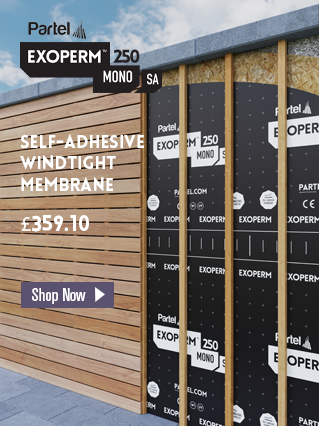U/R Values overview
U/R-values are used to describe the thermal performance of building elements including floors, walls, windows, doors and roofs. This data is then used to calculate the energy performance of the whole building which in turn can impact on the size and cost of the specified insulation, heating system and overall cost of the development. U/R-values are calculated using a range of computerised calculators and in some cases manually. Many u-value calculators also assume that insulation layers are airtight meaning the use of the airtight layer is necessary to achieve specified u-values.
At Partel, we feel that in many cases, the calculated u-values may not truly reflect the installed u-values as the standard of installation can vary greatly. The installation factors that affect u-values are airtightness, windtightness, thermal bypass, damp construction, condensation and cold bridging.
Airtightness
Airtightness and the installation of a vapour control layer (VCL) is possibly the most important part of an installation as it can protect the structure of the roof from condensation, mould and structural damage. It contributes towards noise reduction, and allows and insulation to function correctly.
Breathable Construction
The correct installation of the appropriate VCL will ensure that a breathable construction is achieved which means that condensation of roof felt is avoided and that the roof can effectively ‘breath’ correctly. The quality of the installation is of utmost importance as weak points may be formed, which in certain weather conditions may generate condensation in the roof space. As a result, this may lead to mould and/or timber damage. Ampack’s extensive range of VCL solutions from DB 90 (fixed SD of 23), Resano (variable SD 0.9 to 12m), to Cento (fixed SD 100m), to name a few, ensures that the correct product for each construction type is available. Read more on SD values here.
Thermal Bypass
Thermal bypass can occur when buildings are in fact airtight. When airtight, air can still move around or through insulation. In the roof, this can occur when the felt has not been taped or sealed at the eaves. It can also happen in the walls where external insulation has been poorly fitted or where cavity walls have been partially filled
Windtight
Where a roof or window is not windtight, the performance of insulation can be dramatically affected, in that the wind will cool down the insulation. The location of the project, the exposure of the roof and the quality of the workmanship will determine the effect that the wind will have on the calculated u-value. It can be assumed that that the calculated u-value could adjust by 1.5 times where windtightness is ignored. This may not sound like a lot but consider if you had hoped to achieve a u-value of 0.16 and you actually achieve 0.24, this could result in a significant effect on heating demand and possibly compliance.
Regulation
In Sweden current practice allows for certain adjustments to the u-value of a property and such adjustment may acknowledge external factors such as workmanship, dimensions, services, material properties, wall ties, noggins and wall plates. Such adjustments to the u-value are known as ‘’Delta U’’ and the terms are based upon the difference between calculated and actual (measured) u-values. Contractors may endeavour to reduce the figure through controlled/supervised manufacture and detailed planning. The typical adjustment figure in Sweden is between 5% and 20%.
Summary
Given the recent issues we have with workmanship, planning and supervision we can assume that the overall u-value variations in constructed buildings can exceed or reach 20% as a standard. The implementation of more rigorous inspections may commence next year and that, together with the availability of higher quality materials and better knowledge, should lead to higher quality construction – something which we at Partel are striving to promote. At Partel we supply a complete range of windtight products, all of which are available with integrated windtight tapes for ease of installation. We also recommend that windows and doors be also sealed externally to avoid wind and water ingress using Partel CONEXO tapes.
At Partel our free specification assistance, WUFI analysis and 10 year comprehensive guarantee can give security on the system specification.
References Sean Doran BRE East Kilbride Field investigations of the thermal performance of construction elements as built









